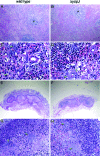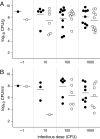Yersinia pestis YopJ suppresses tumor necrosis factor alpha induction and contributes to apoptosis of immune cells in the lymph node but is not required for virulence in a rat model of bubonic plague
- PMID: 16926404
- PMCID: PMC1594864
- DOI: 10.1128/IAI.00219-06
Yersinia pestis YopJ suppresses tumor necrosis factor alpha induction and contributes to apoptosis of immune cells in the lymph node but is not required for virulence in a rat model of bubonic plague
Abstract
The virulence of the pathogenic Yersinia species depends on a plasmid-encoded type III secretion system that transfers six Yop effector proteins into host cells. One of these proteins, YopJ, has been shown to disrupt host cell signaling pathways involved in proinflammatory cytokine production and to induce macrophage apoptosis in vitro. YopJ-dependent apoptosis in mesenteric lymph nodes has also been demonstrated in a mouse model of Yersinia pseudotuberculosis infection. These results suggest that YopJ attenuates the host innate and adaptive immune response during infection, but the role of YopJ during bubonic plague has not been completely established. We evaluated the role of Yersinia pestis YopJ in a rat model of bubonic plague following intradermal infection with a fully virulent Y. pestis strain and an isogenic yopJ mutant. Deletion of yopJ resulted in a twofold decrease in the number of apoptotic immune cells in the bubo and a threefold increase in serum tumor necrosis factor alpha levels but did not result in decreased virulence, systemic spread, or colonization levels in the spleen and blood. Our results indicate that YopJ is not essential for bubonic plague pathogenesis, even after peripheral inoculation of low doses of Y. pestis. Instead, the effects of YopJ appear to overlap and augment the immunomodulatory effects of other Y. pestis virulence factors.
Figures



Similar articles
-
Disparity between Yersinia pestis and Yersinia enterocolitica O:8 in YopJ/YopP-dependent functions.Adv Exp Med Biol. 2007;603:312-20. doi: 10.1007/978-0-387-72124-8_28. Adv Exp Med Biol. 2007. PMID: 17966427
-
The plague virulence protein YopM targets the innate immune response by causing a global depletion of NK cells.Infect Immun. 2004 Aug;72(8):4589-602. doi: 10.1128/IAI.72.8.4589-4602.2004. Infect Immun. 2004. PMID: 15271919 Free PMC article.
-
Role of the Yersinia pestis Ail protein in preventing a protective polymorphonuclear leukocyte response during bubonic plague.Infect Immun. 2011 Dec;79(12):4984-9. doi: 10.1128/IAI.05307-11. Epub 2011 Oct 3. Infect Immun. 2011. PMID: 21969002 Free PMC article.
-
Yersinia pestis and the plague.Am J Clin Pathol. 2003 Jun;119 Suppl:S78-85. doi: 10.1309/DQM9-3R8Q-NQWB-FYU8. Am J Clin Pathol. 2003. PMID: 12951845 Review.
-
Yersinia pestis and pneumonic plague: Insight into how a lethal pathogen interfaces with innate immune populations in the lung to cause severe disease.Cell Immunol. 2024 Sep-Oct;403-404:104856. doi: 10.1016/j.cellimm.2024.104856. Epub 2024 Jul 10. Cell Immunol. 2024. PMID: 39002222 Review.
Cited by
-
YopJ-promoted cytotoxicity and systemic colonization are associated with high levels of murine interleukin-18, gamma interferon, and neutrophils in a live vaccine model of Yersinia pseudotuberculosis infection.Infect Immun. 2010 May;78(5):2329-41. doi: 10.1128/IAI.00094-10. Epub 2010 Mar 15. Infect Immun. 2010. PMID: 20231414 Free PMC article.
-
New insights into how Yersinia pestis adapts to its mammalian host during bubonic plague.PLoS Pathog. 2014 Mar 27;10(3):e1004029. doi: 10.1371/journal.ppat.1004029. eCollection 2014 Mar. PLoS Pathog. 2014. PMID: 24675805 Free PMC article.
-
Amino acid substitutions in LcrV at putative sites of interaction with Toll-like receptor 2 do not affect the virulence of Yersinia pestis.Microb Pathog. 2012 Nov-Dec;53(5-6):198-206. doi: 10.1016/j.micpath.2012.07.003. Epub 2012 Jul 24. Microb Pathog. 2012. PMID: 22841961 Free PMC article.
-
Glutathionylation of Yersinia pestis LcrV and Its Effects on Plague Pathogenesis.mBio. 2017 May 16;8(3):e00646-17. doi: 10.1128/mBio.00646-17. mBio. 2017. PMID: 28512097 Free PMC article.
-
Yersinia pestis endowed with increased cytotoxicity is avirulent in a bubonic plague model and induces rapid protection against pneumonic plague.PLoS One. 2009 Jun 16;4(6):e5938. doi: 10.1371/journal.pone.0005938. PLoS One. 2009. PMID: 19529770 Free PMC article.
References
-
- Butler, T. 1983. Plague and other Yersinia infections. Plenum Press, New York, N.Y.
Publication types
MeSH terms
Substances
Grants and funding
LinkOut - more resources
Full Text Sources
Medical

